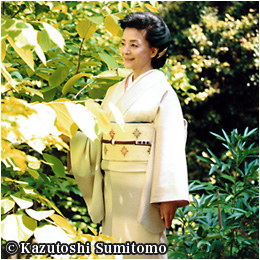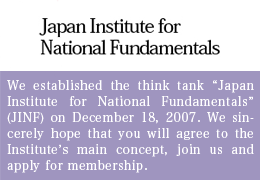Why Japan Should Not Dread China – Time to Utilize Japan’s Abundant Resources Through “Urban Mining”
“It looked like a ghost from afar, but turned out to be just a bunch of tall dead pampas grass swaying in the wind.”
The foregoing is my rendition of a “senryu” — a satirical 17-syllable traditional Japanese poem — reminding one that the reality is rarely as dreadful as one fears. In other words, when overtaken by excessive fear, all things around you look intimidating. It is apparent that Prime Minister Naoto Kan and Chief Cabinet Secretary Yoshito Sengoku, gripped by an inordinate fear of China, have taken “the dead plants for a ghost” in addressing matters involving Japan’s relations with China over the past several weeks.
Since September 19, when Japan extended the detention of the Chinese trawler captain, arrested for violating Japanese territorial waters around the Senkaku Islands in the East China Sea, China has further stepped up its pressure on Japan, halting the export of rare earth elements on September 23 while simultaneously detaining four employees of Fujita, a Japanese construction company with a subsidiary in China. The Chinese actions caught the Japanese government off guard — as was seen in an announcement the following day that Japan would release the trespasser. Japan’s business world reacted no differently.
Repeatedly emphasized among government and business quarters at the time was a grave concern that a sudden stoppage of China’s rare earth exports to Japan would cause its manufacturing industries to immediately come to a complete halt. Not necessarily — if one cares to see the bigger picture. The stoppage will surely hurt Japan up to a point, but the problems will be manageable, as will be explained later. Rather, it will most likely be China that will end up seeing its national interests impaired as a result of the series of extreme measures it has taken. The crudeness of behavior of the Chinese has been clearly apparent to the international community, as evidenced in a recent editorial in the Washington Post in which the Chinese methods were criticized as “19th century mercantilism.”
What are rare earth elements and rare metals in the first place? Mr. Masao Yamada, President and Representative Director of Dowa Holdings Co. Ltd. headquartered in Tokyo, explains that they have four distinct features: 1. Their global deposits are scarce; 2. Mining is extremely costly; 3. Metallization is hideously difficult; and, 4. Demand for them is huge and constantly growing across the globe.
Rare earth elements are indispensable for such products as motors for computer hard disc drives and optical instruments. Performance of these products is vastly improved by mixing such rare earth elements as neodymium, terbium and dysprosium extracted into the steel with which these products are manufactured.
Mr. Yamada points out: “Let us take the motor for a Prius hybrid car, for example, which uses rare earth magnets that are unaffected by conditions like high temperatures. With ordinary neodymium magnets, the magnetism in the motor is inevitably lost when temperatures reach around 300 degrees Celsius. However, a car motor is virtually useless today unless it is weather-proof enough to sustain every possible climatic condition on earth — from the Sahara Desert to the Arctic Circle. Rare earth elements and rare metals are an absolute necessity to allow manufacturing of products of such superb quality.”
Rare metals are said to consist of some 30 different types of metals, including lithium, nickel, ferrovanadium, titan, chrome, and manganese. Noteworthy in our daily life is the use of indium, which is employed to make such electronic devices as liquid crystal displays (LCDs) for cellular phones, computers and television sets.
China’s Weaknesses
Explaining that the world’s rare earth and rare metal markets have characteristics markedly different from those of the other mineral markets, Mr. Yamada notes:
“Most metals are traded in markets around the world, including London, with the standard of quality of each of the resources strictly honored. For instance, copper has to be 99.99% pure. There also are transparent guidelines on international standard prices. However, no such market mechanism exists for rare earths.”
Under the present circumstances which reflect the absence of internationally recognized price standards for the rare earth market, and the international market itself, China — the world’s dominant supplier of rare earths, accounting for 97 percent of the total output — has gotten away with making deals one-on-one with countries as well as enterprises. It is obvious that the rare earth and rare metal markets have consistently been manipulated by China, with prices sky-rocketing the past few years.
For example, in the five years from March 2002 to March 2007, nickel rose 7.1 times per kilogram from $ 6.54 to $46.30, indium 8.5 times from $85 to $720, ferrovanadium 6.2 times from $6.38 to $39.50, and neodymium 4.2 times from $7.30 to $31.00.
As its domestic market has grown, China has changed course from export promotion to export restriction, starting to levy surcharges on rare earth exports in 2005. Initially set at between 5 and 10 percent, the surcharge has gradually been raised, finally reaching the 25 percent mark. Consequently, export volumes have declined drastically, culminating in an abrupt announcement in July this year that the Chinese government will reduce export quotas for Japan by a hefty 40 percent from last year.
These measures involve two major objectives. One, China is dead set on hoarding its own rare earth resources for its current and future domestic consumption. It was for this purpose that China took a step forward in July this year to impose restrictions on the entry of foreign-owned corporations for mineral resource development within China. Meanwhile, China had already established a government-affiliated investment fund for resource development overseas, setting aside a whopping $200 billion.
The second Chinese objective: To induce the transfer to China of cutting-edge technologies from countries coveting rare earths and rare metals — on the understanding that the materials will be made available to foreign corporations if they promise to use them in domestic manufacturing in China instead of exporting them. It would be safe to surmise that the main target of this string of measures is Japanese corporations, who have all too readily buckled under to Chinese pressures. However, a closer look reveals that China has its own weaknesses.
Comments a Japanese rare earth expert on condition of anonymity: “China today prevails as virtually the sole provider of rare earths and rare metals because, to begin with, it came up with prices stunningly lower than any other nations could afford to offer. But I must say that hidden here also lies a significant real problem for China.”
In developing mines around the world today, environmental countermeasures are critical, but not so in China, points out the expert. In fact, it is in remote areas of Yunnan and along the border with Vietnam, as well as those regions belonging to the Tibetans and the Uighurs, that the Chinese actually engage in mining for these precious resources. So even if they continue to neglect the environment, they remain immune to criticisms coming directly from these regions. Meanwhile, development costs are far lower than elsewhere. In addition, labor costs are so small in China that a monthly remuneration of $85 per laborer is by no means rare. “How can any nation dare undercut this and expect to stay in business?” asks the expert.
However, such a modus operandi has inevitably spurred international criticism of China, while sending governments and corporations around the world in vigorous search of alternative sources. In fact, once abandoned rare earth mines are being reopened while new ones are starting up in countries like Australia, Canada, Mongolia, South Africa and the United States.
Used Electronics – Discovering Rich Reservoirs of Coveted Resources Anew
Further, the prices of Chinese rare earths and rare metals will necessarily be reduced in the future because the central government is incapable of controlling local governments, remarks the expert, adding:
“Even if the central government attempts to raise prices to a certain level with hopes of restricting their exports, the local governments will continue to dig for more resources for sales overseas to secure their own income. The resources thus excavated in China will continue to be channeled to international buyers through such neighbors as Vietnam and Hong Kong. As a matter of fact, I have personally witnessed more than a few cases in which antimony and bismuth were smuggled overseas without the central government knowing about it.”
Now that we have reviewed China’s scheme and the actual situation pertaining to rare earths and rare metals in that nation today, let us look into the reality that Japan — a “resources-short” nation — is faced with in terms of the availability of precious resources that its industries cry out for. Believe it or not, Japan actually has an abundance of rare earth elements and rare metals in the form of “urban mines” — stockpiles in towns and cities across the Japanese archipelago of used electronics containing a rich variety of rare earths and metals.
Comments Mr. Yamada: “According to a study conducted by the government-affiliated Japan Institute for Materials Science, Japan has among the world’s biggest deposits of precious resources in its urban mines, easily equaling those of the world’s leading resource-rich nations. For instance, there is estimated to be 6,800 tons of gold in these stockpiles, equaling 16 percent of the total reserves in all the gold mines on earth. We also have a 60,000-ton deposit of silver, which amounts to 22 percent of the world’s known deposits. In the rare metal category, we have plenty of antimony (19% of the world’s deposits), indium (16%), and tantalum (10%). All this means that, in fact, Japan ranks No. 1 as a country in deposits of gold, silver, lead, and indium. Even the total deposits of antimony and indium, which are feared to be nearing depletion, are not in low supply in our urban mines.”
So what does this all mean? It simply means Japan should be more confident of itself. It is only natural that these resources are stored in the form of varied high-tech products, with Japan having been so vigorously engaged in the manufacture of high-quality industrial products over a number of decades. The real challenge now is how to extract the recyclable resources cost-effectively from the deposits in the urban mines and then metalize them.
Japan should take heart from what it has achieved after the bleak oil crises of the 1970s to eventually lead the world in fuel-efficiency technologies. In fact, Japan already has more than a handful of enterprises, including Dowa, that boast the world’s cutting-edge resource-recycling technologies. All Japan needs to do is to rationally restructure vertically integrated industry so as to allow more efficient resource-recycling. In other words, the DPJ must simply forge ahead with an administrative reform, which the ruling party claims to be good at, instead of being intimidated by “tall dead pampas grass swaying in the wind.”
(Translated from “Renaissance Japan” Column No. 431 in the October 14, 2010 issue of The “Weekly Shincho.”)








